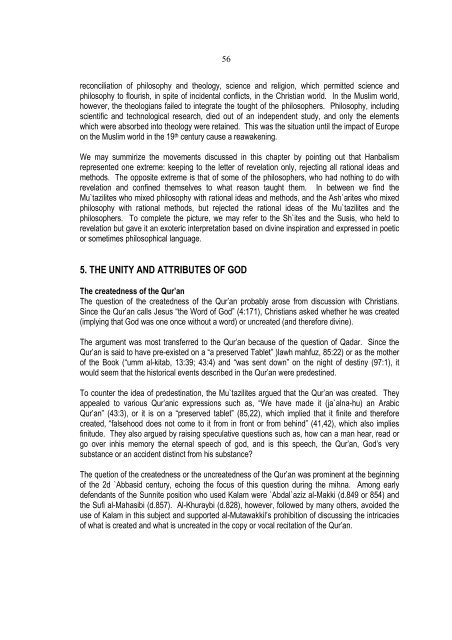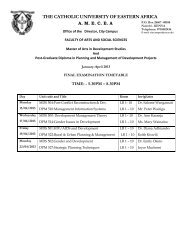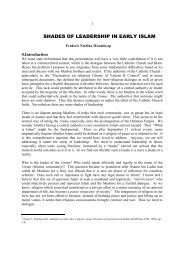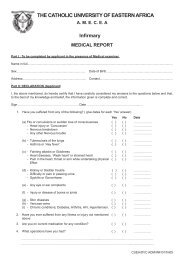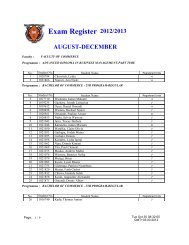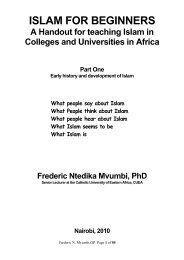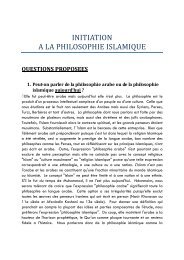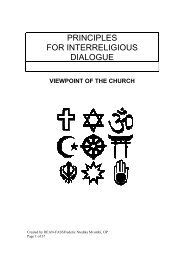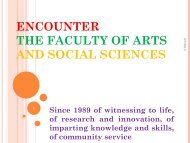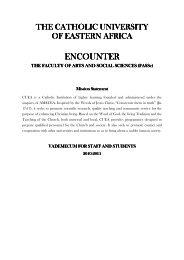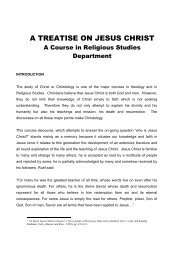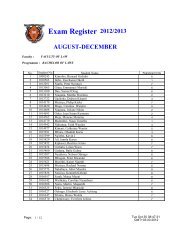INTRODUCTION TO ISLAMIC THEOLOGY.pdf - CUEA
INTRODUCTION TO ISLAMIC THEOLOGY.pdf - CUEA
INTRODUCTION TO ISLAMIC THEOLOGY.pdf - CUEA
Create successful ePaper yourself
Turn your PDF publications into a flip-book with our unique Google optimized e-Paper software.
56reconciliation of philosophy and theology, science and religion, which permitted science andphilosophy to flourish, in spite of incidental conflicts, in the Christian world. In the Muslim world,however, the theologians failed to integrate the tought of the philosophers. Philosophy, includingscientific and technological research, died out of an independent study, and only the elementswhich were absorbed into theology were retained. This was the situation until the impact of Europeon the Muslim world in the 19 th century cause a reawakening.We may summirize the movements discussed in this chapter by pointing out that Hanbalismrepresented one extreme: keeping to the letter of revelation only, rejecting all rational ideas andmethods. The opposite extreme is that of some of the philosophers, who had nothing to do withrevelation and confined themselves to what reason taught them. In between we find theMu`tazilites who mixed philosophy with rational ideas and methods, and the Ash`arites who mixedphilosophy with rational methods, but rejected the rational ideas of the Mu`tazilites and thephilosophers. To complete the picture, we may refer to the Sh`ites and the Susis, who held torevelation but gave it an exoteric interpretation based on divine inspiration and expressed in poeticor sometimes philosophical language.5. THE UNITY AND ATTRIBUTES OF GODThe createdness of the Qur’anThe question of the createdness of the Qur’an probably arose from discussion with Christians.Since the Qur’an calls Jesus “the Word of God” (4:171), Christians asked whether he was created(implying that God was one once without a word) or uncreated (and therefore divine).The argument was most transferred to the Qur’an because of the question of Qadar. Since theQur’an is said to have pre-existed on a “a preserved Tablet” )lawh mahfuz, 85:22) or as the motherof the Book (“umm al-kitab, 13:39; 43:4) and “was sent down” on the night of destiny (97:1), itwould seem that the historical events described in the Qur’an were predestined.To counter the idea of predestination, the Mu`tazilites argued that the Qur’an was created. Theyappealed to various Qur’anic expressions such as, “We have made it (ja`alna-hu) an ArabicQur’an” (43:3), or it is on a “preserved tablet” (85,22), which implied that it finite and thereforecreated, “falsehood does not come to it from in front or from behind” (41,42), which also impliesfinitude. They also argued by raising speculative questions such as, how can a man hear, read orgo over inhis memory the eternal speech of god, and is this speech, the Qur’an, God’s verysubstance or an accident distinct from his substance?The quetion of the createdness or the uncreatedness of the Qur’an was prominent at the beginningof the 2d `Abbasid century, echoing the focus of this question during the mihna. Among earlydefendants of the Sunnite position who used Kalam were `Abdal`aziz al-Makki (d.849 or 854) andthe Sufi al-Mahasibi (d.857). Al-Khuraybi (d.828), however, followed by many others, avoided theuse of Kalam in this subject and supported al-Mutawakkil’s prohibition of discussing the intricaciesof what is created and what is uncreated in the copy or vocal recitation of the Qur’an.


